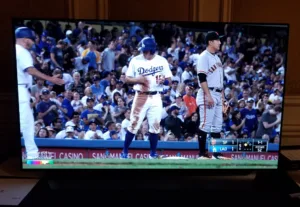In the Technicolor suite in the Venetian, we learned that the HDR solution developed by Technicolor and Philips will be called Advanced HDR by Technicolor when communicating this to the media and consumers. When talking to standards bodies, such as the ATSC 3.0 group, the technology is referred to as SL-HDR1. This is the result of the combination of two SMPTE standards: ST-2094-20 and ST-2094-30 developed by Philips and Technicolor. A bit confusing, huh?
The Technicolor/Philips team has been focusing on the HDR delivery system primarily working hard with ATSC 3.0 to get this version included as an optional delivery format. Just prior to CES, the SL-HDR1 initiative was raised to the status of a “Proposed Standard,” within ATSC 3.0. This means it has been properly vetted, any comments resolved and it is now ready for a vote by all the members. That will clear the path for its addition to the ATSC A/341 standard and broadcasters can begin to implement it if they want to.
Dolby Vision is already approved as an option in ATSC 3.0 and HDR10+ is currently in the Candidate Standard state.
The SL in their standard stands for single layer. The idea is to capture and produce an event in HDR, using HLG, S-Log as well as a mix of SDR cameras converted to an HDR format. Images in SDR and HDR are monitored to be sure each is optimized. In the Master Control room, again the production is done in an HDR format with commercials and graphics upconverted for insertion into the video. Before the signal leaves the production facility, the HDR signal goes through a conversion to SDR with metadata created to be able to reconstruct the HDR signal at the far end of the distribution chain. This SDR signal plus metadata can then be encoded using HEVC and sent over a number of distribution channels. If the TV has an HEVC decoder and a decoder for Advanced HDR by Technicolor, the HDR signal can be extracted from the SDR+metadata stream. This HDR signal will play on HDR TVs using PQ, HLG or even 2.4 gamma EOTFs. If the decoder is not present, the SDR signal is still available.
This is not a fully backwards compatible solution as the signal is encoded in HEVC and many legacy sets do not support decoding this codec. It is also a 10-bit signal whereas SDR signals are 8-bits/color. However, if the signal is decoded in a set top box featuring Advanced HDR by Technicolor, it can deliver an 8-bit SDR signal to legacy TVs.
Technicolor Makes Trials
Technicolor has already done some trial broadcasts to validate the workflow. This included a Dodgers baseball game last summer and a Lakers basketball game last winter. For the LA Dodgers broadcast, the entire production and mix were completed in HDR at Dodger Stadium by Spectrum Network’s standard production crew using equipment provided by NEP, said to be an industry leader in remote live productions and broadcast. Technicolor assisted NEP by converting an Outside Broadcasting (OB) truck with their technology to complete the entire production in HDR. Specifically, Technicolor HDR Intelligent Tone Mapping (ITM) technology was integrated to up-convert all the SDR video feeds to HLG HDR and complete the mix in HDR, while Technicolor’s down conversion was leveraged to ensure all of the SDR partner productions and monitors were receiving a proper SDR version of the game.
The contribution feed was fed to Spectrum Networks Network Operations Center (NOC) in El Segundo, CA for simultaneous distribution in both HDR-10 and Advanced HDR by Technicolor (aka SL-HDR1) for select viewers.
As noted above, TV brands and set top box makers need to adopt decoders for Advanced HDR by Technicolor as well. The team has made good progress in this area as well.
For example, LG Electronics and Philips have both announced that they will add decoders for the format. LG will add it for their 2018 TVs but Philips will wait until the 2019 model year to coincide with more content availability via ATSC 3.0.
For set top boxes and TVs, it is important to get the decoder built into SoCs for set top boxes and third party providers for TV brands. SoCs providers who have already integrated or agreed to integrate decoders include RealTek, MediaTek, Mstar, Marvell, Broadcom and Sigma Designs.
The latest addition announced at CES 2018 is Taiwan-based ALi Corp. They will now offer a set top box chip set that includes Technicolor ITM for SDR to HDR conversion and Advanced HDR by Technicolor for decoding and parsing. (ALi Adopts Advanced HDR by Technicolor in STB Chipsets)
For the broadcast market, Technicolor also announced a new relationship with Cobalt Digital. The company has now agreed to include Technicolor’s ITM technology in its 12G/6G/3G/HD/SD-SDI 4K cards for its openGear platform – as well as its BBG-1000 series of stand-alone units and for certain versions of the 9902-UDX card. Cobalt sees interest in capturing live sports and concepts in HDR and wants to include Technicolor technology as part of their offerings.

